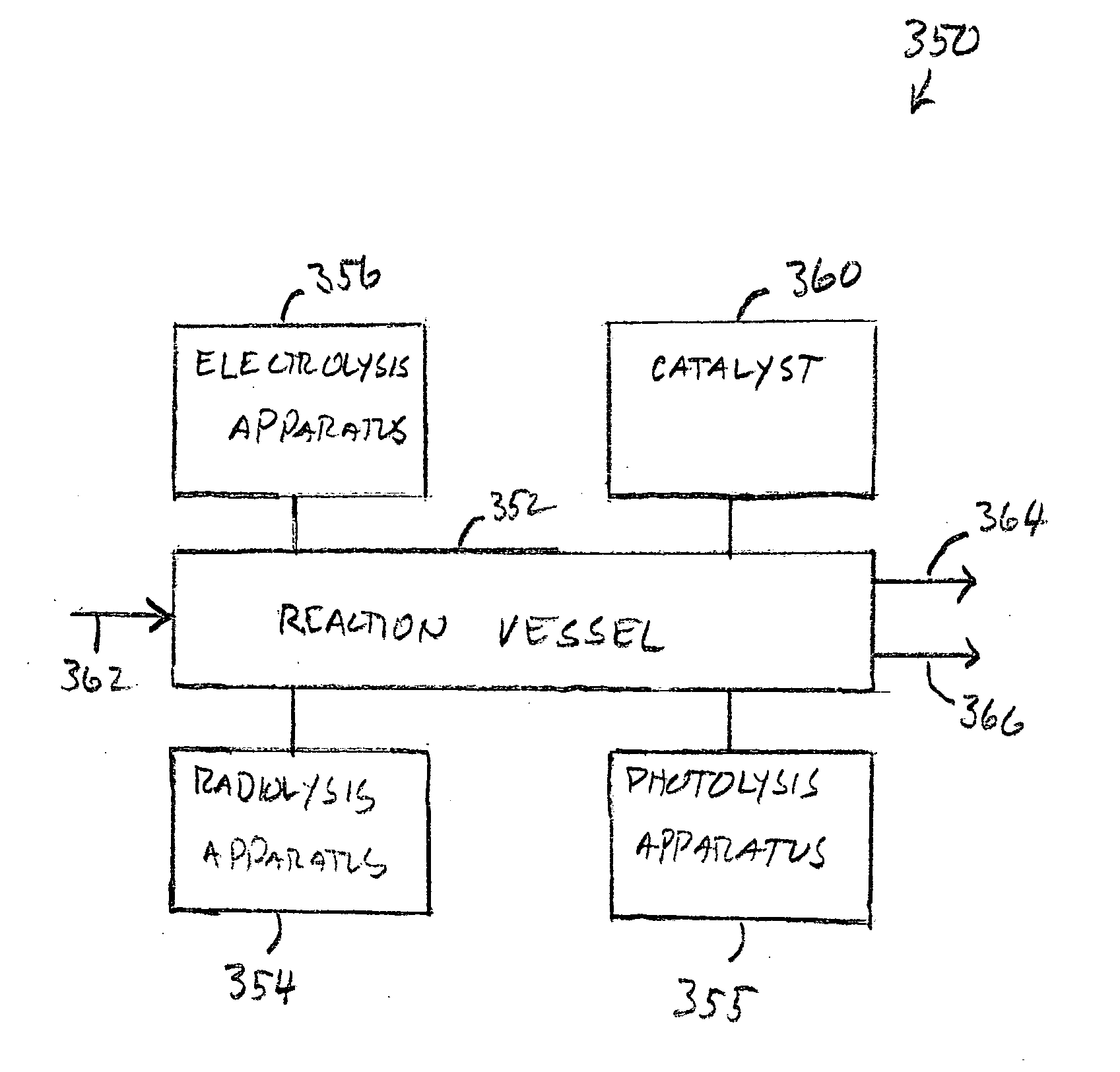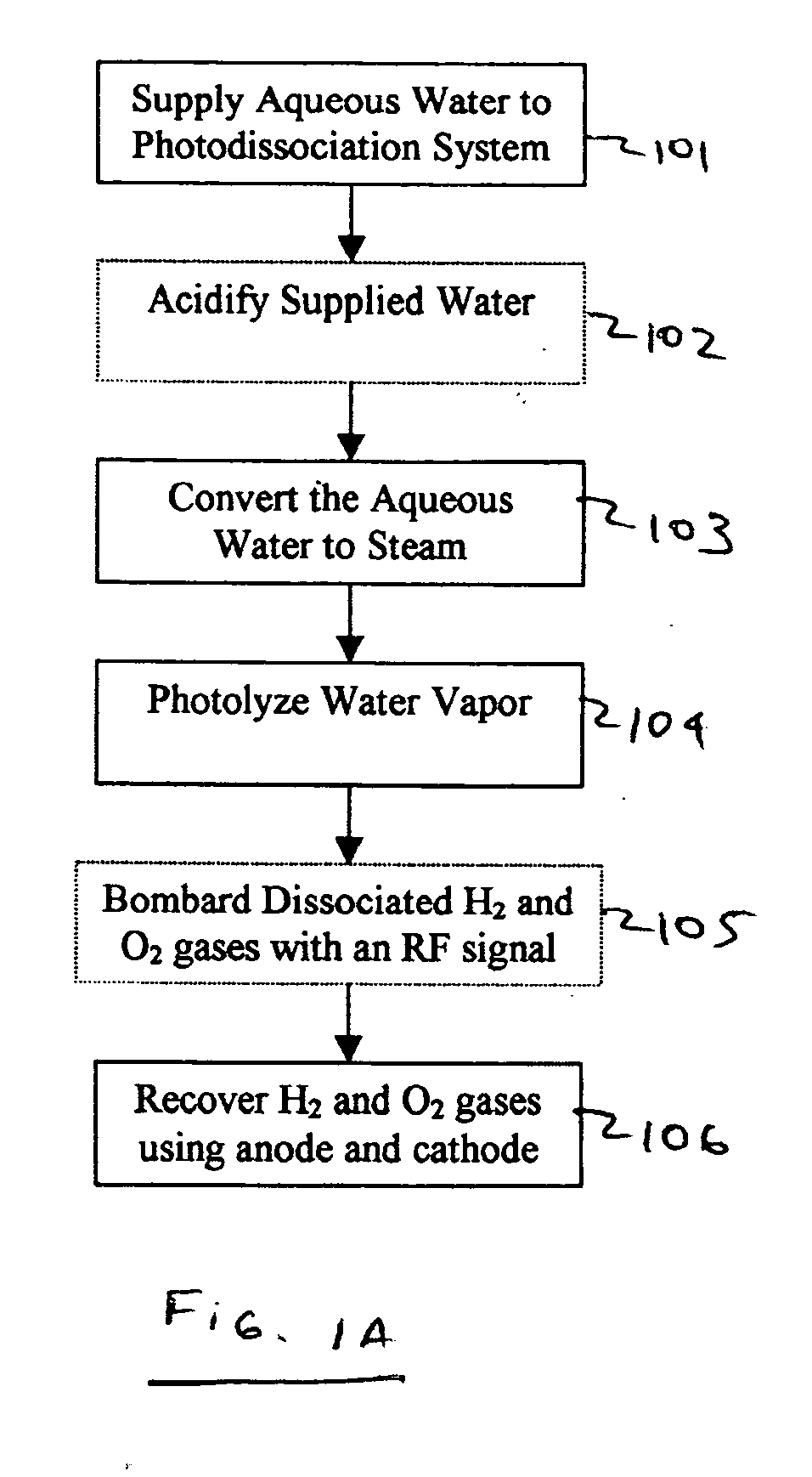Transition structures and catalytic reaction pathways for the production of hydrogen and oxygen
- Summary
- Abstract
- Description
- Claims
- Application Information
AI Technical Summary
Benefits of technology
Problems solved by technology
Method used
Image
Examples
second embodiment
[0039] The bottle 210 further includes an RF port 242 located on or near the wall's outer surface 215, the RF port being configured to electromagnetically couple an RF (radio frequency) signal of predefined frequency(ies) into the interior region 217. In one embodiment, the frequency(ies) of the supplied RF signal is selected to substantially match the resonant frequency(ies) of the acidic water vapor molecule so as to inhibit recombination of the H.sub.2 and O.sub.2 molecules after dissociation. In a second embodiment, the amplitude and frequency of the RF signal is selected so as to bombard the H.sub.2 and O.sub.2 constituents with ionizing radiation, thereby maintaining their present dissociated state. The RF port 242 may comprise any conventional structure operable to launch the desired RF frequency(ies) signal into the interior region 217, such structures including a TEM (transverse electromagnetic) structure such as coaxial cable, or TE (transverse electric) or TM (transverse ...
embodiment 300
[0044]FIG. 5 illustrates an embodiment 300 of a method for dissociation of water molecules in accordance with one embodiment of the present invention. Initially at 302, water is supplied to a reaction vessel, an embodiment of which is shown and described in FIG. 6 below. The supplied water may be from any source, such as a well, a lake, or an ocean as will be described further below. The interior of the reaction vessel has previously been coated with at least one transition metal oxide photo catalyst. Next at 304 and 306, the water is excited and heated by use of RF microwave radiation from a radiolysis apparatus and ultra violet radiation emitted from a photolysis apparatus. The RF microwave radiation is provided by a variable voltage controlled oscillator and a wave guide emitter at a power range of 0.5-5 watts and frequencies of 20 to 25 GHz. The excited water molecules are heated into water vapor. The heated water vapor molecules then separate into H.sub.2 and O.sub.2 molecules,...
embodiment 350
[0045]FIG. 6 shows a simplified block diagram of an embodiment 350 of a dissociation system employing the method illustrated in FIG. 5. The exemplary system illustrates a reaction vessel 352 having an inlet 362 for water, an oxygen outlet 364 and a hydrogen outlet 366, at least one radiolysis mechanism 354, such as RF emitter apparatus in communication with reaction vessel 352, at least one photolysis apparatus 355 in communication with said reaction vessel to inject light into the vessel, at least one electrolysis apparatus 356 in communication with reaction vessel 352 to effect cathode anode migration for the respective gases (oxygen and hydrogen) to exit the vessel, and at least one catalyst 360 located within the interior 358 of said reaction vessel 352.
[0046] Initially in the process, the interior surface of reaction vessel 352 is coated with a transition metal oxide catalyst 370. The transition metal oxide catalyst can be taken from the group selected consisting of titanium di...
PUM
| Property | Measurement | Unit |
|---|---|---|
| Frequency | aaaaa | aaaaa |
| Frequency | aaaaa | aaaaa |
| Wavelength | aaaaa | aaaaa |
Abstract
Description
Claims
Application Information
 Login to View More
Login to View More - R&D
- Intellectual Property
- Life Sciences
- Materials
- Tech Scout
- Unparalleled Data Quality
- Higher Quality Content
- 60% Fewer Hallucinations
Browse by: Latest US Patents, China's latest patents, Technical Efficacy Thesaurus, Application Domain, Technology Topic, Popular Technical Reports.
© 2025 PatSnap. All rights reserved.Legal|Privacy policy|Modern Slavery Act Transparency Statement|Sitemap|About US| Contact US: help@patsnap.com



